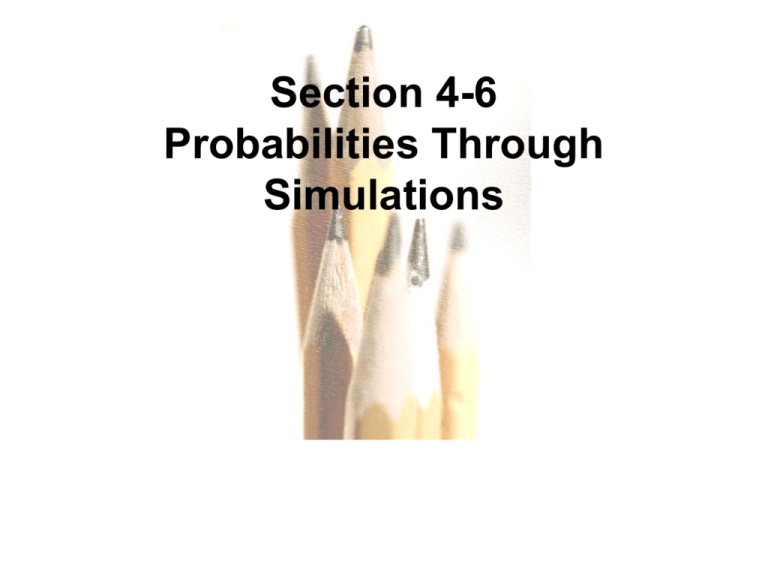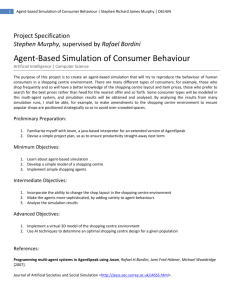n 1
advertisement

Section 4-6 Probabilities Through Simulations Slide 1 Warm Up 1) At a certain elementary school, the probability that a student who is randomly selected will come from a two-parent home is 0.75, and the probability that he or she will come from a two-parent home and me a lo achiever (D’s and F’s) is 0.18. What is the probability that such a randomly selected student will be a low achiever given that he or she comes from a two-parent home? 2) What is the probability of getting two aces in a row when two cards are drawn from an ordinary deck of 52 playing cards, if: a) The first card is replaced before the second card is drawn b) The first card is not replaced before the second card is drawn 3) If the probability is 0.70 that any person interviewed at a shopping mall will be against rezoning a certain piece of property for industrial development, what is the probability that among four persons interviewed at the mall the first three will be against the rezoning but the forth one will not be against it? 4) The typical single engine aircraft uses redundancy with two separate, independent electrical systems. Suppose the prob. Of one system failing is 0.1. If an aircraft has two electrical systems, find the probability of a safe flight. 5) A homeowner finds that there is a 0.1 probability that a flashlight does not work when turned on. If she has 3 flashlights: a) Find the prob. that none of them work when there is a power failure. b) Find the probability that at least one of them works when there is a power failure. c) Find the prob. That the second flashlight works given that the first flashlight works. Slide 2 Key Concept In this section we introduce a very different approach for finding probabilities that can overcome much of the difficulty encountered with the formal methods discussed in the preceding sections of this chapter. Slide 3 Definition A simulation of a procedure is a process that behaves the same way as the procedure, so that similar results are produced. Slide 4 Random Numbers In many experiments, random numbers are used in the simulation of naturally occurring events. Below are some ways to generate random numbers. A table of random of digits STATDISK Minitab Excel TI-83 Plus calculator Slide 5 Simulation Example Gender Selection When testing techniques of gender selection, medical researchers need to know probability values of different outcomes, such as the probability of getting at least 60 girls among 100 children. Assuming that male and female births are equally likely, describe a simulation that results in genders of 100 newborn babies. Slide 6 Simulation Examples Solution 1: Flipping a fair coin 100 times where H H T female female male H T female male T male heads = female and tails = male H H H H male female female female Solution 2: Generating 0’s and 1’s with a computer or calculator where 0 = male 1 = female 0 0 male male 1 0 female male 1 1 1 0 female female female male 0 0 male male Slide 7 More simulation examples 1) If Bertha makes 70% of her free-throw basketball shots, design and run a simulation to represent the shots she misses and makes, running 100 trials; use Line 101 from your random digit table. 2) Globe Activity: We want to simulate the percentage of the earth that is covered in water vs. land. What is the actual percentage? What is the simulated percentage? Slide 8 Random Numbers - cont STATDISK Minitab Slide 9 Random Numbers - cont Excel TI-83 Plus calculator Slide 10 Recap In this section we have discussed: The definition of a simulation. How to create a simulation. Ways to generate random numbers. Slide 11 Section 4-7 Counting Slide 12 Key Concept In many probability problems, the big obstacle is finding the total number of outcomes, and this section presents several methods for finding such numbers without directly listing and counting the possibilities. Slide 13 Fundamental Counting Rule For a sequence of two events in which the first event can occur m ways and the second event can occur n ways, the events together can occur a total of m n ways. Slide 14 Examples-FCR 1) In designing a test of gender-selection method, a researcher wants to know how many different possible sequences of genders there are when 10 babies are born. What are the number of possibilities? 2) Assume that a criminal is found using your social security number and claims that all of the digits were randomly generated. What is the probability of getting your social security number when randomly generating nine digits? If the criminal claims they randomly generated your number, is this likely to be true? Slide 15 Notation The factorial symbol ! denotes the product of decreasing positive whole numbers. For example, 4! 4 3 2 1 24. By special definition, 0! = 1. Slide 16 Factorial Rule A collection of n different items can be arranged in order n! different ways. (This factorial rule reflects the fact that the first item may be selected in n different ways, the second item may be selected in n – 1 ways, and so on.) Slide 17 Example You are planning a trip to Disney World and you want to get through these five rides the first day: Space Mountain, Tower of Terror, Rock ‘n’ Roller Coaster, Mission Space, and Dinosaur. The rides can sometimes have long waiting lines that vary throughout the day, so planning an efficient route could help maximize the pleasure of the day. How many different routes are possible? Slide 18 Permutations Rule (when items are all different) Requirements: 1. There are n different items available. (This rule does not apply if some of the items are identical to others.) 2. We select r of the n items (without replacement). 3. We consider rearrangements of the same items to be different sequences. (The permutation of ABC is different from CBA and is counted separately.) If the preceding requirements are satisfied, the number of permutations (or sequences) of r items selected from n available items (without replacement) is nPr = n! (n - r)! Slide 19 Examples-Permutations 1) Singing legend Frank Sinatra recorded 381 songs. From a list of his top-10 songs, you must select 3 that will be sung in a medley as a tribute at the next MTV Music Awards ceremony. If you select 3 of Sinatra’s top-10 songs, how many different sequences are there? 2) When testing a new drug, Phase I involves only 8 volunteers, and the objective is to assess the drug’s safety. To be very cautious, you plan to treat the 8 subjects in sequence, so that any particularly adverse effect can allow for stopping the treatments before any other subjects are treated. If 10 volunteers are available and 8 of them are to be selected, how many different sequences of 8 subjects are possible? Slide 20 Permutations Rule (when some items are identical to others) Requirements: 1. There are n items available, and some items are identical to others. 2. We select all of the n items (without replacement). 3. We consider rearrangements of distinct items to be different sequences. If the preceding requirements are satisfied, and if there are n1 alike, n2 alike, . . . nk alike, the number of permutations (or sequences) of all items selected without replacement is n! n1! . n2! .. . . . . . . nk! Slide 21 Permutations – identical to others With 10 births, how many ways can 8 girls and 2 boys be arranged in sequence? What is the probability of getting 8 girls and 2 boys among 10 births? Slide 22 Combinations Rule Requirements: 1. There are n different items available. 2. We select r of the n items (without replacement). 3. We consider rearrangements of the same items to be the same. (The combination of ABC is the same as CBA.) If the preceding requirements are satisfied, the number of combinations of r items selected from n different items is n! nCr = (n - r )! r! Slide 23 Examples - Combinations 1) 2) When testing a new drug on humans, a clinical test is normally done in 3 phases. Phase I is conducted with a relatively small number of healthy volunteers. If 8 subjects are selected from the 10 that are available, and the 8 selected subjects are all treated at the same time, how many different treatment groups are possible? (Not “in sequence”). In designing a test of gender-selection method with 10 couples, a researcher knows that there are 1024 different possible sequences of genders when 10 babies are born. What is the probability of getting 8 girls and 2 boys among 10 births? Slide 24 Permutations versus Combinations When different orderings of the same items are to be counted separately, we have a permutation problem, but when different orderings are not to be counted separately, we have a combination problem. Slide 25 The local Chamber of Commerce conducted a survey of one thousand randomly selected shoppers at a mall. For all shoppers, “gender of shopper,” and “items shopping for” was recorded. The data collected is summarized in the following table: Clothes Shoes Other Total 75 25 150 250 Female 350 230 170 750 Total 255 320 1000 Male 425 If the shopper is selected at random from this mall, a) What is the probability that the shopper is a female? b) What is the probability that the shopper is shopping for shoes? c) What is the probability that the shopper is a female shopping for shoes? d) What is the probability that the shopper is shopping for shoes given that the shopper is a female? e) Are the events “female” and “shopping for shoes” disjoint? f) Are the events “female” and shopping for shoes” independent? Slide 26






